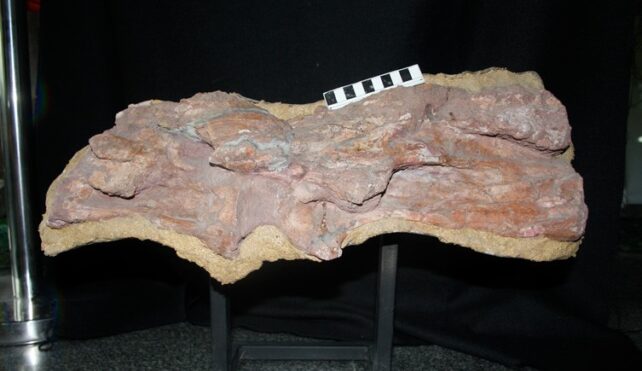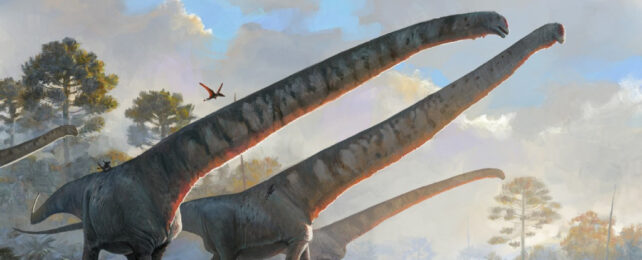A plant-eating dinosaur that once grazed the greenery in what is today northwest China could hold the title of the longest neck ever known, according to a new analysis of its fossilized bones.
Mamenchisaurus sinocanadorum was unearthed from fossil beds in northwest China in 1987 and named in 1993.
Revisiting the fossil and comparing its size and structure to other long-necked sauropods, a team of researchers estimates M. sinocanadorum's neck stretched out a distance 15.1 meters (49 feet) – an "exceptional feat" of bizarre proportions made possible by their air-filled, honeycomb-like vertebrae.
"At the time of its discovery, M. sinocanadorum was hailed as the largest sauropod from Asia, and it retains the distinction of having one of the longest necks known for any sauropod species," Stony Brook University paleontologist Andrew Moore and colleagues write in their published paper.
Feeding is the most obvious purpose neck of such proportion, providing added reach to reduce the need to lug a giant body around or perhaps to nibble at hard-to-reach material. Yet access to nutrition isn't the only primal need that drives evolution. Like the giraffes of the Jurassic, long necks might have benefited in multiple ways.
"It could have also been to do with sexual display or used for neck-butting contests between males fighting over mates and territory, similar to how giraffes behave today," says study author and paleobiologist Paul Barrett, of the UK National History Museum.
"But we can't say for sure. At this point, it's pure speculation as to why they evolved necks of this length."
Only one fossil of M. sinocanadorum has been found so far: an incomplete skeleton consisting of three neck vertebrae, a rib, and a few skull bones. That's it.
To work out how far its neck stretched, the researchers compared the bones of M. sinocanadorum to more complete fossils of other sauropods with intact necks, landing on a whopping 15 meters in length for M. sinocanadorum.

But how sauropods, and especially M. sinocanadorum, managed to balance their exceptionally long necks continues to puzzle scientists. A similarly long tail might have stopped sauropods from toppling over, but how could a beast like M. sinocanadorum lift its head without collapsing under the weight of its neck? What about its turning circle, should something approach it from behind?
"We really have no idea how that animal would have worked mechanically," says Barrett. "It would require a lot of muscles to hold up a neck that size, and then there's the question of how it gets air down to the lungs and back up again."
At least on that last point, Barrett and his colleagues aren't totally in the dark. Using CT scans, the researchers were able to peek into the fossilized neck bones to help theorize ways M. sinocanadorum managed to suck in enough air.
Like all sauropod dinosaurs and their living relatives, birds, M. sinocanadorum had numerous balloon-like air sacs all the way down its windpipe, into its lungs and chest. These air sacs even formed hollows insides their bones, creating a lattice of air pockets larger than the lungs themselves.
Based on imaging, the researchers estimate these air sacs made up 69 to 77 percent of M. sinocanadorum's neck bones.
"Such a lightweight build would have been critical to lightening the gargantuan necks of the largest sauropods," explains Moore in The Guardian.
However, without further bony reinforcements, their lightweight skeletons would have been a flop, and more prone to injury – not so great for headbutting away their rivals. It turns out that M. sinocanadorum also had neck ribs, extensions of the vertebrae that stiffened and stabilized its neck.
For all the hoo-ha about M. sinocanadorum being the longest-necked dinosaur discovered to date, the odds are that it lived alongside other larger, longer sauropods that we just haven't met yet.
"All sauropods were big, but jaw-droppingly long necks didn't evolve just once," says Moore. "With a 15-meter-long neck, it looks like Mamenchisaurus sinocanadorum might be a record-holder – at least until something longer is discovered."
The research has been published in Journal of Systematic Palaeontology.
